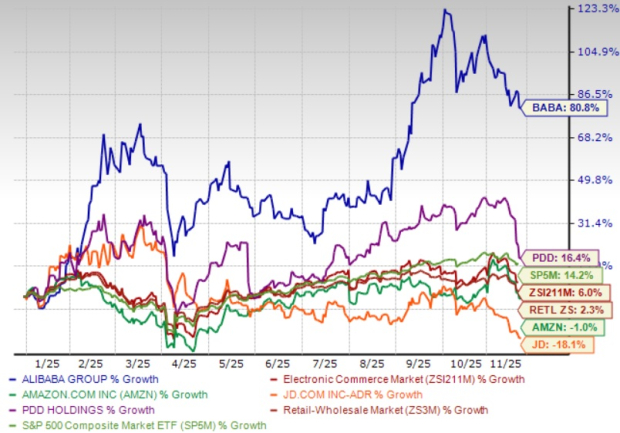Should You Hold Or Fold Alibaba Stock Ahead Of Q2 Earnings?

Image: Bigstock
Key Takeaways
- Alibaba reports Q2 fiscal 2026 earnings on Nov. 25, with revenues expected to rise 2.17% year-over-year.
- Alibaba shares surged 80.8% year-to-date but face headwinds from China deflation and PDD competition.
- Heavy AI investments and quick commerce subsidies are compressing margins amid weak consumer sentiment.
Alibaba Group Holding Limited (BABA - Free Report) is scheduled to report second-quarter fiscal 2026 results on Nov. 25.
For the fiscal second quarter, the Zacks Consensus Estimate for revenues is pegged at $34.43 billion, suggesting a 2.17% rise from the year-ago quarter’s reported figure. The Zacks Consensus Estimate for earnings is pinned at 66 cents per share, indicating a decline of 69.3% from the prior-year quarter’s reported figure.

Image Source: Zacks Investment Research
Alibaba has a mixed earnings surprise history. In the last reported quarter, the company delivered a negative earnings surprise of 3.29%. Its earnings beat the Zacks Consensus Estimate in two of the trailing four quarters and missed the same twice, with the average surprise being 0.97%.
Alibaba Group Holding Limited Price and EPS Surprise
Image Source: Zacks Investment Research | Alibaba Group Holding Limited Quote
Earnings Whispers for Alibaba
Our proven model does not conclusively predict an earnings beat for Alibaba this time around. The combination of a positive Earnings ESP and a Zacks Rank #1 (Strong Buy), #2 (Buy) or #3 (Hold) rating increases the odds of an earnings beat. This is not the case here. You can uncover the best stocks to buy or sell before they are reported with our Earnings ESP Filter.
Alibaba has an Earnings ESP of 0.00% and a Zacks Rank #5 (Strong Sell) rating at present.
Factors to Note for Alibaba Ahead of Q2 Results
Investors should exercise caution ahead of Alibaba's second-quarter fiscal 2026 earnings, as mounting challenges threaten to undermine the e-commerce giant's performance. The September quarter is likely to have reflected intensifying headwinds that are expected to weigh heavily on results.
China's deflationary environment deepened during the quarter, with consumer prices falling 0.4% year-over-year in August and 0.3% in September, signaling persistent weakness in domestic demand that constrains Alibaba's core commerce business. The company's aggressive investments in quick commerce and instant delivery services, while strategically necessary, compressed margins as management prioritized market share over profitability. These heavy subsidies for Taobao Instant Commerce expansion are likely to have eroded adjusted EBITA significantly.
Competitive pressures from PDD Holdings' (PDD - Free Report) value-focused positioning continued to intensify, forcing Alibaba into destructive price wars that squeezed margins further. The company's customer management revenue growth momentum decelerated as the positive impact from software service fees implemented in fiscal 2025 began diminishing, creating difficult year-over-year comparisons.
While Cloud Intelligence Group maintained momentum with AI-related revenues exceeding 20% of external customer revenues, the RMB 380 billion three-year commitment to AI and cloud infrastructure front-loaded massive capital expenditures that will pressure near-term profitability. The proposed Banma Network Technology spin-off announced in August signals capital reallocation away from core operations.
Revenue growth is likely to have remained constrained by weak consumer sentiment and sluggish retail sales growth. These structural headwinds position Alibaba unfavorably for sustained earnings growth despite cloud segment strength.
Alibaba Price Performance & Stock Valuation
Alibaba shares have surged 80.8% in the year-to-date period, outperforming the industry, the Zacks Retail-Wholesale sector, and the S&P 500 index’s return of 6%, 2.3%, and 14.2%, respectively.
However, Alibaba faces tough competition from Amazon (AMZN - Free Report), JD.com (JD - Free Report) and PDD Holdings, among others. While Amazon and JD.com have declined 1% and 18.1%, respectively, in the year-to-date period, PDD Holdings has gained 16.4%.
Year-to-Date Price Performance

Image Source: Zacks Investment Research
Alibaba has been trading at a premium with a forward 12-month P/S of 2.36X compared with the Zacks Internet - Commerce industry’s 2.26X, reflecting a stretched valuation.
Alibaba's P/S Forward 12-Month Ratio Depicts Stretched Valuation

Image Source: Zacks Investment Research
Investment Thesis
Alibaba's second-quarter fiscal 2026 results will likely underscore why investors should avoid the stock at recent levels. Despite trading at a premium valuation, the company faces deteriorating fundamentals as China's deflationary pressures persist and PDD Holdings' aggressive competition erodes market share through relentless price wars.
Management's massive RMB 380 billion AI infrastructure commitment and quick commerce subsidies are compressing margins significantly while revenue growth decelerates amid weakening consumer sentiment. The Banma spin-off and intensifying rivalry suggest limited near-term catalysts. Prudent investors should wait for a more attractive entry point after earnings clarity emerges and valuation concerns diminish substantially.
Conclusion
Given China's persistent deflation, intensifying competition from PDD Holdings, and heavy AI investments pressuring margins, investors should remain cautious on Alibaba ahead of the second quarter of fiscal 2026 earnings. Waiting for a clearer turnaround signal and a more attractive entry point appears wise given current uncertainties.
More By This Author:
Investing In Quantum's Next Wave: IonQ, D-Wave, Rigetti Positioned To WinBuy Target Or Walmart Stock After Beating Q3 EPS Expectations?
Does Nvidia Stock Still Have Enough Mojo To Buy?
Disclosure: Zacks.com contains statements and statistics that have been obtained from sources believed to be reliable but are not guaranteed as to accuracy or completeness. References to any ...
more



